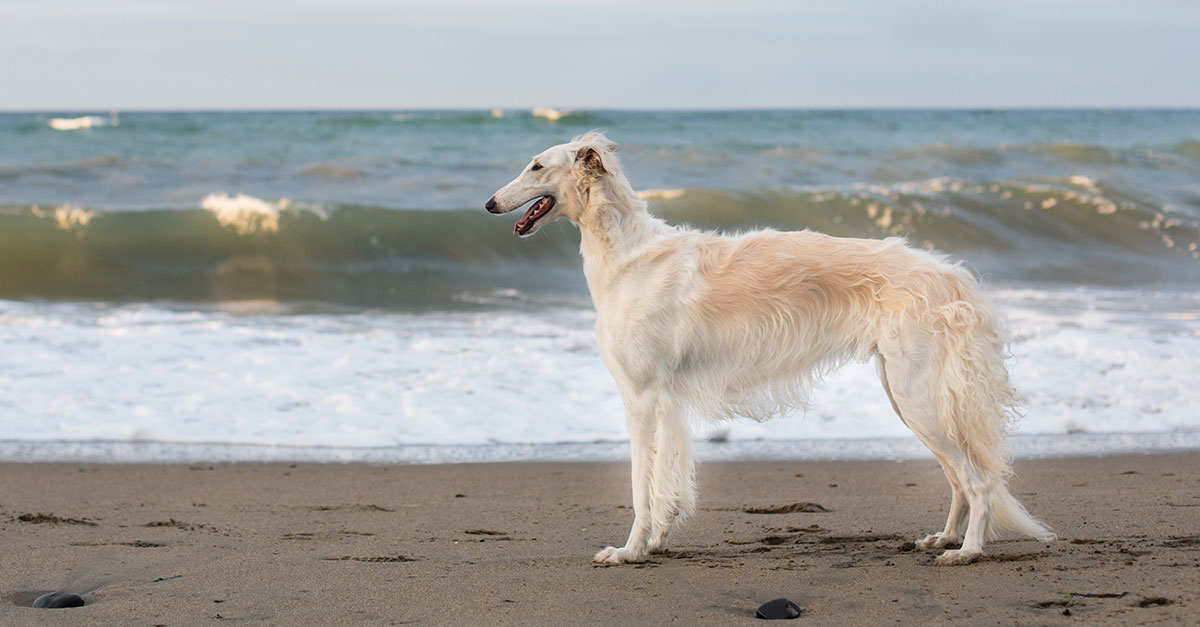
Borzoi – Hound
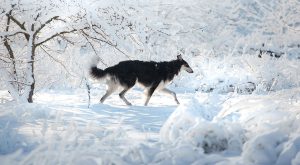
Image: Viktoriia Bondarenko/Shutterstock.com
| Name | Borzoi - Hound |
|---|---|
| Size | Medium - Large |
| Grooming | Moderate |
| Training | Challenging |
| Exercise | At least a long walk a day |
| Origins | Russia |
The Borzoi Russia's Answer To The Greyhound
Big but graceful enough to be in the Russian Bolshoi Ballet
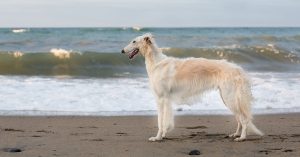
Image: Anastasiia Cherniavskaia/Shutterstock.com
Quick Overview
Name: The Borzoi, the Borzaya (Greyhound), or the Russian Wolfhound
Size: Up to 85 cm tall
Weight: Up to 105 lbs (they get big)
Grooming: They need brushed if you don’t want hair all over your floor
Training: They are highly stubborn but can be trained
Exercise: Fairly energetic – 2 hours plus per day
Temperament: Think Princess and the Pea
Lifespan: 11-15 years
Origins: Russia by way of 17th-century Asian migrants
Breed Type: Hound
Quick History of the Borzoi Breed
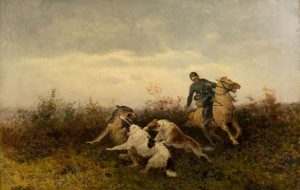
Wolf Hunt With Borzois By Efim A. Tikhmenev (1869-1934) / Public domain
This dog breed is native to the far east of Russia, where it came over with Asian migrants sometime previous to the 17th century. The breed is thought to be descended from the Arabian Greyhound and several other breeds of longer haired dogs. They were intentionally adapted to have thicker coats in order to make them warmer in the far east.
They were bred to help hunters, specifically, they were bred to be big enough to take out wolves. Teams of them would go out with Russian nobility, who would find the wolf, set the dogs to chase it, and they would pin its neck until the men could come and kill it. Not pleasant, but when you own land in remote Russia you can’t have the wolves eating your livestock.
A Noble Breed
There is a whole period in time where these dogs were ‘claimed’ by the nobility. For many years, the only way to get one was to befriend the Tsar, who gave them out as gifts to his favourites. Up until 1917, when the revolution hit, these dogs were a prized possession. During the 20th century, the breed went into sharp decline, since they were associated with the nobility and all the badness that had brought the country.
It wasn’t until the 40’s when a caring Russian named Constantin Esmont detailed the differences between them from place to place and decided to set a breed standard, that they got some of their popularity back. Up until then, some of them had already been exported around the world – thankfully – because otherwise, the breed was cutting it thin in terms of survival. Nowadays you will find them in the AKC, the UKC, and the United Kingdom Kennel Club.
Nowadays, they are high-value dogs, recognised for their ability to hunt. They are loyal, surprisingly ferocious despite their graceful appearance, and will love you until the end of time. If you want a big dog with plenty of energy and love to give, consider the Borzoi… you would be doing the breed a favour.
Top Facts About Your New Borzoi Puppy!
There are fun things you ought to be aware of about any dog breed you choose to accept into your life. If that breed happens to be a Borzoi, then all the more so. They are a nimble, delicate looking dog that can be hilarious in the right situations. Here are the Five Minutes Spare favourite fun facts about the Borzoi breed:
- Their name is descended from the masculine Russian adjective for ‘fast’.
- Have you ever heard of my Little Russian Lady? There is a famous social media borzoi that you need to know about. You can watch a reel here.
- They are a sighthound. This means they are hunters that will chase by sight, not hunt by smell. Keep them on the lead if you are in the countryside.
- Unlike other refined breeds, the Borzoi can have a coat of virtually any or many colours
- Other dogs of the same size include the Malamute, the Newfoundland, or the St. Bernard. So they are not small!
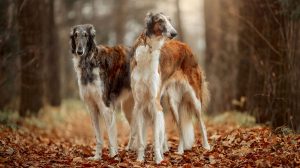
As you can see they can be multicoloured and still purebred
Image: Julia Shepeleva/Shutterstock.com
So if you do have a new Borzoi puppy, you should consider yourself incredibly lucky indeed!
How Often Do You Brush a Borzoi?
Your new Borzoi puppy will shed pretty heavily once every year. You really don’t need to groom them daily, but at that time of year, you are better brushing them than letting it get all over the place. Besides anything else, most dogs enjoy the bonding experience. Keep an eye on and trim their claws and do remember to brush their teeth.
Are they Hard to Train?
They are on the stubborn and independent side of the training scale… not easy for an inexperienced dog owner. Get them into obedience training ASAP, socialise them (although they’re generally not territorial) and be ready to work hard. The term ‘selective learner’ keeps coming up. So although you may think your Borzoi is dense, it’s probably just ignoring you. They are extremely sensitive dogs too, so don’t be shouting at them or you will never get them to heel.
How Much Exercise Does My Borzoi Need?
For a big breed, they are agile and nimble and also heavier than they look. Add to this the fact that they are fast dogs, originally bred to help Russian hunters find food in the cold reaches of nowhere and you will not be surprised to hear that they are not house dogs. They’re hardy, speedy, love the outdoors and need more than two hours of running time a day. This definitely isn’t a breed for someone who works all day and or doesn't enjoy being physically active. Further, they are probably not the best choice if you live in a flat or small townhouse with no garden. If this is the case we would point you to some of the smaller dogs.
Are Borzois Healthy Dogs?
They have been around since prior to the 18th century, so in that time they have managed to accrue a few health defects. Elbow, hip, and kneecap problems are all common in large dogs. Joint problems are a primary problem for the Borzoi. You will need to talk to your vet about nutrition early on in this puppy’s life. They were traditionally fed table scraps or hunter’s cut-offs, so kibble can upset them.
Where Can I Buy a Borzoi Puppy?
Anyone can buy a Borzoi beauty of their very own to love and to cherish… but in order to get one that hasn’t been bred by a puppy farmer, make sure to find a registered breeder through your local kennel club. Better yet, ask around at local shelters to see if any show up. They are increasingly popular dogs, so it isn’t beyond the realms of possibility.
Not Your Favourite Breed?
That’s OK. If you are an avid dog lover then it is exceedingly difficult to decide what breed is best. We advise that you chose based on what dog breed will match your lifestyle, instead. For instance, if you work 6-8 hours a day and need a low-exercise dog, check out the Bolognese. If you are on the farm all day moving between tasks, you need something bigger… try a Bernese Mountain Dog on for size. For everything else, check our pages. We have loads of breeds for you to choose from!